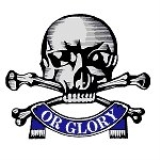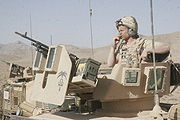
The Queen's Royal Lancers
Encyclopedia

Cavalry regiments of the British Army
There are currently nine regular cavalry regiments of the British Army, with two tank regiments provided by the Royal Tank Regiment, traditionally classed alongside the cavalry, for a total of eleven regiments. Of these, five serve as armoured regiments, and five as formation reconnaissance...
of the British Army
British Army
The British Army is the land warfare branch of Her Majesty's Armed Forces in the United Kingdom. It came into being with the unification of the Kingdom of England and Scotland into the Kingdom of Great Britain in 1707. The new British Army incorporated Regiments that had already existed in England...
. It was formed in 1993 by the amalgamation of two other regiments:
- 16th/5th Queen's Royal Lancers
- 17th/21st Lancers17th/21st LancersThe 17th/21st Lancers was a cavalry regiment of the British Army from 1922 to 1993.It was formed in 1922 in England by the amalgamation of the 17th Lancers and the 21st Lancers . From 1930 to 1939 it was deployed overseas; first in Egypt for two years, and then in India for seven...
From its formation, the regiment served in the armoured role with first Challenger 1
Challenger 1 tank
The British FV4030/4 Challenger 1, was the main battle tank of the British Army from 1983 to the mid 1990s, when it was superseded by the Challenger 2. It is also currently used by the Jordanian Armed Forces as their main battle tank after heavy modifications...
, then Challenger 2
Challenger 2 tank
FV4034 Challenger 2 is a British main battle tank currently in service with the armies of the United Kingdom and Oman. It was designed and built by the British company Vickers Defence Systems . The manufacturer advertises it as the world's most reliable main battle tank...
. However, in 2005, as part of the re-organisation
Delivering Security in a Changing World
The 2003 Defence White Paper, titled Delivering Security in a Changing World, set out the future structure of the British military, and was preceded by the 1998 Strategic Defence Review and the 2002 SDR New Chapter, which responded to the immediate challenges to security in the aftermath of the...
of the army, the regiment started converting to the formation reconnaissance role
Formation reconnaissance regiment
The Formation Reconnaissance Regiment is one of two organisations currently provided by cavalry regiments of the British Army. Until recently, it was known as the Armoured Reconnaissance Regiment....
, re-equipping with the FV107 Scimitar
FV107 Scimitar
FV107 Scimitar is an armoured reconnaissance vehicle used by the British Army. It is very similar to the FV101 Scorpion but mounts a high velocity 30 mm L21 RARDEN cannon instead of a 76 mm gun. It was issued to Royal Armoured Corps, Armoured Regiments in the Reconnaissance role...
armoured reconnaissance vehicle.
Organisation
The regiment is organised into four squadrons, each of which perpetuates one of the antecedent regiments:- 16th Lancer16th The Queen's LancersThe 16th The Queen's Lancers was a cavalry regiment in the British Army, first raised in 1759. It saw service for two centuries, before being amalgamated into the 16th/5th Lancers in 1922.-History:...
Squadron - 17th Lancer17th LancersThe 17th Lancers was a cavalry regiment of the British Army, notable for its participation in the Charge of the Light Brigade in the Crimean War...
Squadron - 21st Lancer21st LancersThe 21st Lancers were a cavalry regiment of the British Army, created in 1858 and amalgamated to form the 17th/21st Lancers in 1922...
Squadron - 5th Lancer5th Royal Irish LancersThe 5th Royal Irish Lancers was a cavalry regiment of the British army originally formed in 1689 as James Wynne's Regiment of Dragoons.They fought in the Battle of the Boyne and at the Battle of Aughrim under William of Orange...
Squadron
Traditions
The regiment's nickname, the 'Death or Glory Boys', comes from their cap badgeCap badge
A cap badge, also known as head badge or hat badge, is a badge worn on uniform headgear and distinguishes the wearer's nationality and/or organisation. The wearing of cap badges is a convention commonly found among military and police forces, as well as uniformed civilian groups such as the Boy...
which is known as "the motto". This is the combined cap badges of the two antecedent regiments, and features a pair of crossed lance
Lance
A Lance is a pole weapon or spear designed to be used by a mounted warrior. The lance is longer, stout and heavier than an infantry spear, and unsuited for throwing, or for rapid thrusting. Lances did not have tips designed to intentionally break off or bend, unlike many throwing weapons of the...
s, from the 16th/5th Queen's Royal Lancers, together with a Totenkopf
Totenkopf
The Totenkopf is the German word for the death's head and an old symbol for death or the dead. It consists usually of the skull and the mandible of the human skeleton...
(death's head), below which is a ribbon containing the words 'Or Glory'. This comes from the 17th/21st Lancers, and was the cap badge of the 17th Lancers
17th Lancers
The 17th Lancers was a cavalry regiment of the British Army, notable for its participation in the Charge of the Light Brigade in the Crimean War...
(the original 'Death or Glory Boys').
Battle honours
16th/5th battle honoursCombined honours before amalgamation of 16th and 5th Lancers:
- BlenheimBattle of BlenheimThe Battle of Blenheim , fought on 13 August 1704, was a major battle of the War of the Spanish Succession. Louis XIV of France sought to knock Emperor Leopold out of the war by seizing Vienna, the Habsburg capital, and gain a favourable peace settlement...
, RamilliesBattle of RamilliesThe Battle of Ramillies , fought on 23 May 1706, was a major engagement of the War of the Spanish Succession. For the Grand Alliance – Austria, England, and the Dutch Republic – the battle had followed an indecisive campaign against the Bourbon armies of King Louis XIV of France in 1705...
, OudenardeBattle of OudenardeThe Battle of Oudenaarde was a key battle in the War of the Spanish Succession fought on 11 July 1708 between the forces of Great Britain, the Dutch Republic and the Holy Roman Empire on the one side and the French on the other...
, MalplaquetBattle of MalplaquetThe Battle of Malplaquet, fought on 11 September 1709, was one of the main battles of the War of the Spanish Succession, which opposed the Bourbons of France and Spain against an alliance whose major members were the Habsburg Monarchy, Great Britain, the United Provinces and the Kingdom of...
, Beaumont, Willems, Talavera, Fuentes d'Onor, SalamancaBattle of SalamancaThe Battle of Salamanca saw Anglo-Portuguese and Spanish armies under the Duke of Wellington defeat Marshal Auguste Marmont's French forces among the hills around Arapiles south of Salamanca, Spain on July 22, 1812 during the Peninsular War....
, VittoriaBattle of VitoriaAt the Battle of Vitoria an allied British, Portuguese, and Spanish army under General the Marquess of Wellington broke the French army under Joseph Bonaparte and Marshal Jean-Baptiste Jourdan near Vitoria in Spain, leading to eventual victory in the Peninsular War.-Background:In July 1812, after...
, NiveBattle of the NiveThe Battles of the Nive were fought towards the end of the Peninsular War. Arthur Wellesley, Marquess of Wellington's Anglo-Portuguese and Spanish army defeated Marshal Nicolas Soult's French army in a series of battles near the city of Bayonne.Unusually, for most of the battle, Wellington...
, PeninsulaPeninsular WarThe Peninsular War was a war between France and the allied powers of Spain, the United Kingdom, and Portugal for control of the Iberian Peninsula during the Napoleonic Wars. The war began when French and Spanish armies crossed Spain and invaded Portugal in 1807. Then, in 1808, France turned on its...
, WaterlooBattle of WaterlooThe Battle of Waterloo was fought on Sunday 18 June 1815 near Waterloo in present-day Belgium, then part of the United Kingdom of the Netherlands...
, Bhurtpore, Ghuznee 1839Battle of GhazniThe Battle of Ghazni took place in city of Ghazni in central Afghanistan on July 23, 1839 during the First Anglo-Afghan War.-Prelude:...
, Afghanistan 1839, Maharajpore, AliwalBattle of AliwalThe Battle of Aliwal was fought on 28 January 1846 between the British and the Sikhs. The British were led by Sir Harry Smith, while the Sikhs were led by Ranjodh Singh Majithia...
, SobraonBattle of SobraonThe Battle of Sobraon was fought on 10 February 1846, between the forces of the British East India Company and the Sikh Khalsa Army, the army of the Sikh Empire of the Punjab...
, Suakin 1885SuakinSuakin or Sawakin is a port in north-eastern Sudan, on the west coast of the Red Sea. In 1983 it had a population of 18,030 and the 2009 estimate is 43, 337.It was formerly the region's chief port, but is now secondary to Port Sudan, about 30 miles north. The old city built of coral is in ruins...
, Relief of Kimberley, PaardebergBattle of PaardebergThe Battle of Paardeberg or Perdeberg was a major battle during the Second Anglo-Boer War. It was fought near Paardeberg Drift on the banks of the Modder River in the Orange Free State near Kimberley....
, Siege of Ladysmith, South Africa 1899-1902Second Boer WarThe Second Boer War was fought from 11 October 1899 until 31 May 1902 between the British Empire and the Afrikaans-speaking Dutch settlers of two independent Boer republics, the South African Republic and the Orange Free State...
- First World War: Mons, Le Cateau, Retreat from Mons, Marne 1914, Aisne 1914, Messines 1914, Ypres 1914 '15, Bellewaarde, Arras 1917, Cambrai 1917, Somme 1918, St. Quentin, Pursuit to Mons
After amalgamation of 16th and 5th Lancers:
- Second World WarWorld War IIWorld War II, or the Second World War , was a global conflict lasting from 1939 to 1945, involving most of the world's nations—including all of the great powers—eventually forming two opposing military alliances: the Allies and the Axis...
: Kasserine, Fondouk, Kairouan, Bordj, Djebel Kournine, Tunis, Gromballa, Bou Ficha, North Africa 1942-43, Cassino II, Liri Valley, Monte Piccolo, Capture of Perugia, Arezzo, Advance to Florence, Argenta Gap, Traghetto, Italy 1944-45
- Wadi al Batin, Gulf 1991
17th/21st battle honours
Combined honours before amalgamation of 17th and 21st Lancers:
- Alma, Balaklava, Inkerman, Sevastopol, Central India, South Africa 1879, Khartoum, South Africa 1900-02
- First World War: Festubert, Somme 1916 '18, Morval, Cambrai 1917 '18, St. Quentin, Avre, Hazebrouck, Amiens, Pursuit to Mons, France and Flanders 1914-18, N.W. Frontier India 1915 '16
After amalgamation of 17th and 21st Lancers:
- Second World WarWorld War IIWorld War II, or the Second World War , was a global conflict lasting from 1939 to 1945, involving most of the world's nations—including all of the great powers—eventually forming two opposing military alliances: the Allies and the Axis...
: Tebourba Gap, Bou Arada, Kasserine, Thala, Fondouk, El Kourzia, Tunis, Hammam Lif, North Africa 1942-43, Cassino II, Monte Piccolo, Capture of Perugia, Advance to Florence, Argenta Gap, Fossa Cembalina, Italy 1944-45
Queen's Royal Lancers
After amalgamation of 16th/5th Lancers and the 17th/21st Lancers into the Queens' Royal Lancers:
- Al Basrah, Iraq 2003
- Maysaan/Al Basrah 2006 (Telic 9)
- Afghanistan 2008 (Herrick)
- Afghanistan 2010 (Herrick 12)
Alliances
- Lord Strathcona's Horse (Royal Canadians) - 12th/16th Hunter River Lancers12th/16th Hunter River Lancers
The 12th/16th Hunter River Lancers is an Australian Army Reserve light armoured regiment. The Regiment was formed on 1 May 1948, although it draws its lineage from units that were originally formed in the 1880s. It is currently a Light Cavalry Scout unit and equipped with Bushmaster Protected...
- HMS Ark Royal
HMS Ark Royal (R07)
HMS Ark Royal is a decommissioned light aircraft carrier and former flagship of the Royal Navy. She was the third and final vessel of Invincible-class...

